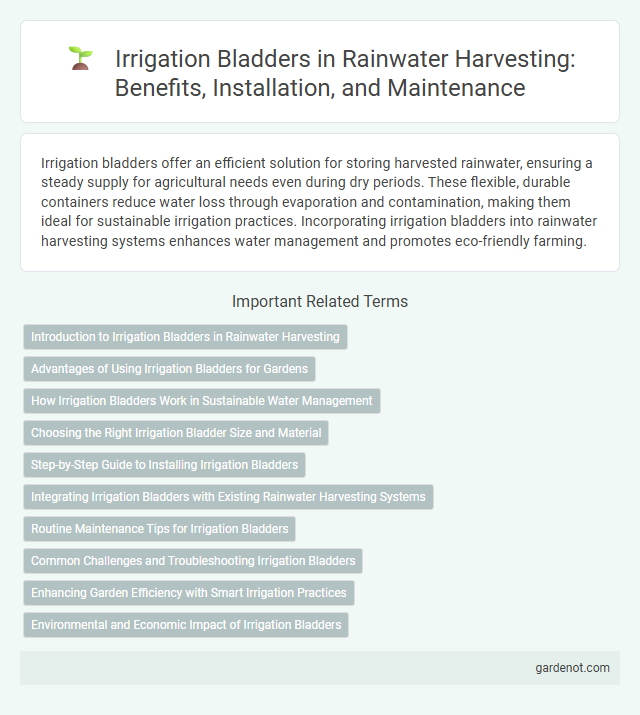Irrigation bladders offer an efficient solution for storing harvested rainwater, ensuring a steady supply for agricultural needs even during dry periods. These flexible, durable containers reduce water loss through evaporation and contamination, making them ideal for sustainable irrigation practices. Incorporating irrigation bladders into rainwater harvesting systems enhances water management and promotes eco-friendly farming.
Introduction to Irrigation Bladders in Rainwater Harvesting
Irrigation bladders serve as flexible water storage solutions for rainwater harvesting systems, enabling efficient water management in agricultural and landscape irrigation. These bladders are designed to store collected rainwater and release it gradually, reducing water waste and improving irrigation precision. Their lightweight, collapsible nature allows easy transport and installation, making them ideal for sustainable water conservation practices in various settings.
Advantages of Using Irrigation Bladders for Gardens
Irrigation bladders offer efficient water storage and distribution, reducing water waste and ensuring consistent soil moisture for healthier plant growth. Their portable design allows easy placement in gardens, optimizing space and enhancing water conservation during dry periods. Using irrigation bladders supports sustainable gardening by minimizing runoff and promoting deep root hydration essential for thriving gardens.
How Irrigation Bladders Work in Sustainable Water Management
Irrigation bladders store harvested rainwater in flexible, durable containers that maintain water quality and pressure for efficient distribution. These bladders release water gradually, optimizing moisture levels in soil and reducing evaporation compared to traditional irrigation methods. Their portability and scalability make them essential for sustainable water management in agricultural and landscaping applications.
Choosing the Right Irrigation Bladder Size and Material
Selecting the appropriate irrigation bladder size depends on the scale of your rainwater harvesting system and the specific irrigation needs, with common capacities ranging from 20 to 500 gallons. Material choices like UV-resistant polyethylene or reinforced PVC ensure durability and prevent leakage, maintaining water quality during prolonged outdoor storage. Proper sizing and material selection optimize water distribution efficiency, reduce maintenance, and enhance system longevity in sustainable irrigation practices.
Step-by-Step Guide to Installing Irrigation Bladders
Installing irrigation bladders for rainwater harvesting begins with selecting a durable, UV-resistant bladder compatible with the volume of collected rainwater. Proper site preparation ensures a flat, debris-free surface for placing the bladder, followed by securely connecting it to the irrigation system using appropriate fittings and valves. Regular maintenance, including inspecting for leaks and cleaning intake filters, maximizes efficiency and prolongs bladder lifespan.
Integrating Irrigation Bladders with Existing Rainwater Harvesting Systems
Integrating irrigation bladders with existing rainwater harvesting systems enhances water storage efficiency by utilizing collected rainwater for precise irrigation needs. These flexible bladders connect seamlessly with gutters and downspouts, allowing direct storage of rainwater for controlled release during dry periods. This integration reduces dependence on traditional water sources and supports sustainable landscape management with optimized water conservation.
Routine Maintenance Tips for Irrigation Bladders
Regularly inspect irrigation bladders for leaks, punctures, and signs of wear to ensure efficient rainwater storage and distribution. Clean bladders with mild soap and water to prevent algae buildup, which can obstruct water flow and reduce lifespan. Store bladders in a cool, shaded area when not in use to avoid UV damage and prolong durability.
Common Challenges and Troubleshooting Irrigation Bladders
Irrigation bladders often face challenges such as leaks, blockages, and uneven water distribution, which can lead to inefficient rainwater harvesting. Common troubleshooting methods include inspecting for punctures, clearing filter screens, and ensuring proper bladder positioning to maintain consistent pressure. Regular maintenance reduces downtime and maximizes the effectiveness of irrigation systems relying on harvested rainwater.
Enhancing Garden Efficiency with Smart Irrigation Practices
Irrigation bladders optimize rainwater harvesting by storing and distributing collected water directly to garden plants, reducing water waste and promoting efficient irrigation. Integrating these bladders with smart irrigation systems ensures precise water delivery based on soil moisture levels, enhancing plant health and conserving resources. Their flexibility and ease of installation make irrigation bladders a sustainable solution for maximizing harvested rainwater in home gardens.
Environmental and Economic Impact of Irrigation Bladders
Irrigation bladders significantly reduce water wastage by delivering precise amounts of rainwater directly to plant roots, enhancing water use efficiency in agriculture. This technology lowers reliance on groundwater and reduces energy consumption associated with traditional irrigation systems, contributing to environmental sustainability. Economically, irrigation bladders decrease water costs and maintenance expenses, offering farmers a cost-effective solution that promotes sustainable crop production.
Irrigation bladder Infographic

 gardenot.com
gardenot.com